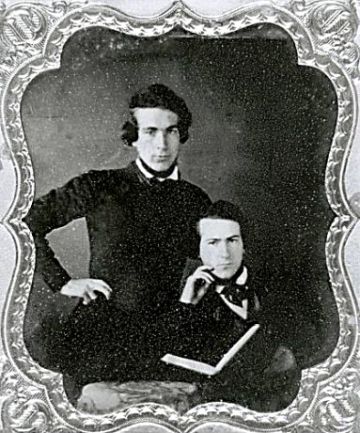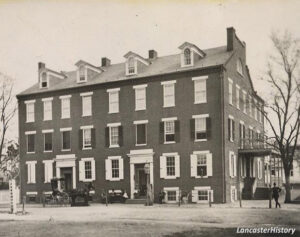Eureka!
When gold was discovered at Sutter’s Mill just west of Sacramento in 1848, thousands of people flocked to California to get in on the action. The following is a selection of brave, adventurous (and maybe a bit foolhardy) men from Lancaster County who ventured west in search of gold, silver and whatever riches they could find. Some were luckier than others.

Hosea Ballou Grosh and his brother, Ethan Allen Grosh, discovered the Comstock Lode in the Virginia Range in Nevada, but sadly, they wouldn’t lay claim to the fame. Hosea was born August 23, 1826 and Ethan was born November 7, 1824 – both in Marietta to Rev. Aaron B. Grosh. The lode was discovered in 1857, but both brothers died before they could lay claim to it. Hosea Grosh injured his foot and died of septicemia in September of 1857 in Nevada. Ethan Allen Grosh entrusted their belongings to Henry Comstock, a fellow miner, while he went off to California to raise funds to file the claim. Ethan Allen Grosh died, in of all places, a town called Last Chance in Placer County, California, deep in the Sierra Nevada Mountains in December 1857. He never made it to Sacramento to file his claim. Henry Comstock took their claim and went down in history as the famous finder of the first major vein of silver in the United States.
David Baer Hackman was born in Manheim in 1827 and left for California in the fall of 1849. In the spring of 1850, he took a steamboat from Cincinnati to St. Louis and then made the arduous journey by wagon train to California. He arrived in California in the fall of 1850. In a letter written to his brother Andrew from Hangtown, now Placerville, on November 7, 1850, he said that “everything is ten times as dear here as it is in the States. I haind Boarded at a Boarding house since I am Here, I Board myself me and two other young men Build a shanty for the winter season.”
Hackman later moved south to Yankee Hill, near Columbia, California. It would take three years of hard work before he saw his best day of mining. In a letter to his brother from Yankee Hill, he states in a letter written May 28, 1853 that “I made the biggest days work in this claim that I made since I been in the country. We took out of our claim in course of six weeks about $1400… Last week we took out 21 ounces which make the nice little sum of $377… gold dust is worth $17.50 per ounce.”
Hackman spent another year in the gold mines before returning to Pennsylvania via steamer from San Francisco, train over the Panama isthmus and another steamer to New York. He returned to Manheim where he died in 1896. Hackman’s letters to his family and his journal kept while in California are found in MG 72 David B. Hackman Collection in our archives.
Paris Haldeman, brother of noted scientist Samuel S. Haldeman, arrived in Sacramento, California, on September 5, 1849. Ten days later he wrote to his mother, describing his journey and the city of Sacramento, saying that town had a population of about 7,000, had much gambling, and was generally good for business. He also mentioned “Capt. Sutter” and heading to Carson River, east of Sacramento in the Sierra Nevada Mountains, and Yuba City, north of Sacramento. By October 28, 1849, he made it to “Reading’s Diggings”, somewhere near Redding, California, about 200 miles north of Sacramento. From here he wrote to one of his brothers about his journey so far, the hard work, and wanting to return home. An excerpt from this letter:
“We are now located in Reading’s Dry Diggings two hundred miles north of Sacramento City near the Sacramento River, We will winter here although the diggings are now poor, there have been so many here that the creek bottoms have been completely torn up and it is difficult to find ten feet square to dig on. I do not think the average amount made by the miners exceeds five dollars per day. Many do not make sufficient to pay their boarding, some may strike a pocket and take out two or three hundred dollars in a few hours. The largest amt. that has been taken out in a day here lately was three hundred & eighty five dollars.”
His favorite part of California? The horses: “The only thing this country affords are beautiful horses, which are here in any quantity… It is a perfect show to see a California Vaquero with his horse trappings, his sarape and blanket – the most beautiful sight is to see them lasso wild cattle, which the valley is covered with…”
Paris Haldeman was born in 1831 and died in 1893. This letter and few others are part of MG 736 Haldeman Family Papers and Business Records in our archives.
John and Urias Bitzer – Urias, born 1826, and John, born 1833 – set off from Lancaster County in 1856, sailing from New York City to San Francisco. By 1860 they had made their way to Mud Springs Township, El Dorado County – northeast of San Francisco – where they tried their luck at prospecting.
In 1861, John took off, sailing from San Francisco to Portland, Oregon, and made his way along the Yakima River in Washington all the way to Ingalls Creek before returning to Portland. He eventually made his way to Helena, Montana, where he died in 1870. A copy of John’s diary kept while on his Washington prospecting trip is found in the Bitzer family file in our Research Center.

Urias eventually gave up prospecting and settled in Woodland, Yolo County, California, in 1877 where he took up what comes naturally to a man from Earl Township, Lancaster County – farming. He raised dairy cattle and grapes on 20 acres of land with great success. He was well known in the community and died there in 1904.
And let’s not forget John Augustus Sutter, on whose California land all this goldrushing began. Born in 1803 in Switzerland, he arrived in California in 1839 and established Fort Sutter and Sutter’s Mill, both east of Sacramento. Gold was discovered on his land in 1848, leading to the big gold rush of 1849. Although he tried to keep the gold discovery quiet, word got out and his land was overrun with prospectors. A series of bad land disputes left him in financial distress. He settled in Lititz in 1871 and began appealing to Congress to reimburse him for his lost property in California. He died in Washington, DC, in 1880, waiting to find out about reimbursement. He’s buried in the Moravian Cemetery in Lititz. The General Sutter House is located at 17 – 19 Main Street in Lititz.
From PhotoBlog